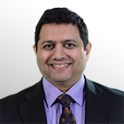Playlist
Show Playlist
Hide Playlist
Mixed Agonists/Antagonists and Antagonists – Opioid Analgesics
-
Slides Mixed Agonists Antagonists Antagonists Opioid Analgesics.pdf
-
Reference List Pharmacology.pdf
-
Download Lecture Overview
00:01 Let's move on to the mixed agonists, antagonists class of drugs. So, these are harder to understand, but this is where the receptors start to come into play. 00:11 Let's talk about Nubain. Now, Nubain will not antagonize other opioid drugs. It may still be addictive however. 00:20 It is an agonist at the kappa receptor and an antagonist at the mu receptor. 00:25 What this gives us is a "respiratory ceiling". So, what that means is, is that even if you give very high doses of this drug, it does not increase the risk of respiratory depression. There is also a lower risk of addiction. 00:39 And in fact, this particular agent was taken off the class II list of controlled substances by the FDA. 00:47 It is also used for morphine induced itching or pruritus, so that you don't get as many histamine reactions from this medication. Now, you're unlikely to be tested on this drug, at least in the past, I don't know if this is going to be on the exams in the future. 01:05 So although it hasn't been tested on extensively in the past, just be aware of it and keep your eyes and ears open. 01:18 Now, this is another morphine analogue. It is a semisynthetic partial agonist. 01:24 Uses are in opioid addiction with methadone, for use in some pain management patients, it is found to be effective in refractory depression as well, and there is a particular condition called neonatal abstinence syndrome. 01:39 This is why this drug is on our list because it is used in those patients who are neonates, who are survivors of mothers who are addicted to morphine. 01:49 Going on, in terms of it's activity at different receptor sites at the mu receptor, it's a weak partial agonist. 01:55 Remember that it binds very tightly so it will stay bound to that receptor for a long time. 02:01 In terms of the kappa receptor, it's a weak agonist, and in terms of the delta receptor, it's an antagonist. 02:08 Now, we do have an unusual concern about this medication is because it binds very tightly to the mu receptor, it will not respond to additional stronger opioids except for sufentanil or Sufenta. 02:23 Why is this a problem? If patients have breakthrough pain while they're on this medication, we can't add another opioid agonist. Now, Sufenta is the most powerful of the opioids. 02:37 You're not going to get tested on it, it's about 100 times more powerful than fentanyl, and about 800 times more powerful than morphine. 02:45 It's an extremely strong agent, and it's used almost exclusively in anesthesia. 02:52 Alright, the antagonists, naloxone. Naloxone is also called Narcan. 03:00 I do think it's important to know the trade name because in the crash kits or in the code kits, it will often be labelled Narcan instead of its chemical name naloxone. 03:09 So, it is worthwhile for clinical practice to know its trade name, for your exam it's not as important. 03:15 It is a synthetic mu receptor pure competitive antagonist or blocker. 03:22 We use it for blocking or reversing toxicity from opioids. It may be used in conjunction with the opioid, to prevent excessive mental and respiratory depression. 03:34 Side effects. In patients on opioids, you may cause sweating. Now patient who aren't taking opioids shouldn't have any side effects. But there is actually something that is very interesting that we've started to see. 03:48 It's called placebo pain control syndrome. Now, patients who let's say twisted an ankle but don't really feel much pain, when you give them naloxone, they start to feel pain. And we believe it's because naloxone is blocking the endorphin related pain control that the body is producing on its own. 04:06 So sometimes you can get an increase in pain when you're using naloxone. 04:12 Okay, there you have it. These are all of the opioid analgesics. 04:15 Just have a look at the listed names and medications, and just try to remember what kind of receptors they block.
About the Lecture
The lecture Mixed Agonists/Antagonists and Antagonists – Opioid Analgesics by Pravin Shukle, MD is from the course CNS - Pharmacology. It contains the following chapters:
- Opioid Analgesics - Mixed Agonists/Antagonists
- Opioid Analgesics - Antagonists
Included Quiz Questions
A reduced capacity for which side effect makes nalbuphine a safer alternative to morphine?
- Respiratory depression
- Sedation
- Dizziness
- Arrhythmia
- Acute renal failure
What is the downside to using buprenorphine?
- Because of its strong binding affinity, buprenorphine prevents the use of other, stronger opioids for pain management.
- Buprenorphine is very addictive and should not be prescribed to any patient with a history of substance abuse.
- It has a significantly higher risk of respiratory depression compared to morphine.
- Buprenorphine is contraindicated during pregnancy.
- A high rate of arrhythmias prevents chronic use for withdrawal.
What is not expected after naloxone administration for opioid toxicity?
- Hallucination
- Sweating
- Improved spontaneous respirations
- Vomiting
- Agitation
Which medication may be appropriate for neonatal abstinence syndrome with a history of opioid abuse during pregnancy?
- Buprenorphine
- Naloxone
- Flumazenil
- Fentanyl patch
- Nicotine patch
Customer reviews
5,0 of 5 stars
| 5 Stars |
|
1 |
| 4 Stars |
|
0 |
| 3 Stars |
|
0 |
| 2 Stars |
|
0 |
| 1 Star |
|
0 |
Well done. It was easy to comprehend. This will help me greatly for my exams.




